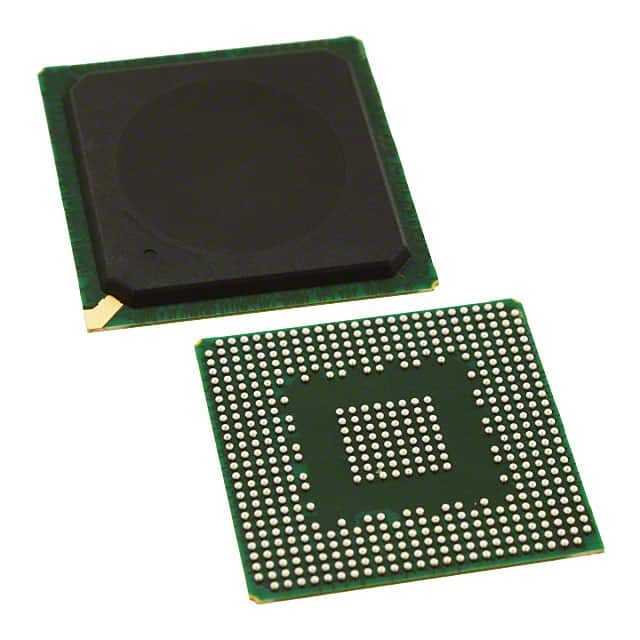Consulte las especificaciones para obtener detalles del producto.

MPC8313EVRAFFB
Product Overview
- Category: Integrated Circuit (IC)
- Use: Embedded Processor
- Characteristics: High-performance, low-power consumption
- Package: BGA (Ball Grid Array)
- Essence: PowerPC-based System-on-Chip (SoC)
- Packaging/Quantity: Tray, 100 units per tray
Specifications
- Architecture: PowerPC e300 Core
- Clock Speed: Up to 333 MHz
- Cache: 32 KB Instruction Cache, 32 KB Data Cache
- Memory: External DDR2/DDR3 SDRAM Interface
- Connectivity: Ethernet, USB, UART, I2C, SPI
- Operating Voltage: 1.2V
- Operating Temperature: -40°C to +105°C
Detailed Pin Configuration
The MPC8313EVRAFFB has a total of 516 pins arranged in a specific configuration. The pinout diagram and detailed pin descriptions can be found in the product datasheet.
Functional Features
- High-performance processing capabilities
- Low-power consumption for energy-efficient applications
- Integrated peripherals for connectivity options
- Support for various operating systems and development tools
- Enhanced security features for data protection
Advantages and Disadvantages
Advantages: - Powerful processing capabilities suitable for demanding applications - Low power consumption extends battery life in portable devices - Wide range of integrated peripherals simplifies system design - Support for multiple operating systems and development tools offers flexibility
Disadvantages: - Relatively high cost compared to lower-end processors - Limited clock speed compared to some modern processors - BGA package may require specialized equipment for soldering and rework
Working Principles
The MPC8313EVRAFFB is based on the PowerPC e300 core architecture. It integrates a processor core, memory controller, and various peripherals into a single chip. The processor executes instructions and performs calculations, while the memory controller manages data access to external DDR2/DDR3 SDRAM. The integrated peripherals provide connectivity options for communication with other devices.
Detailed Application Field Plans
The MPC8313EVRAFFB is widely used in various embedded systems applications, including: - Industrial automation - Networking equipment - Telecommunications infrastructure - Automotive electronics - Medical devices
Detailed and Complete Alternative Models
- MPC8315EVRAFFB: Similar to MPC8313EVRAFFB but with higher clock speed (up to 400 MHz)
- MPC8314EVRAFFB: Similar to MPC8313EVRAFFB but with additional features like PCI Express interface
- MPC8312EVRAFFB: Lower-cost version of MPC8313EVRAFFB with reduced features and performance
These alternative models offer different specifications and features to cater to specific application requirements.
Note: The content provided above is a summary and may not cover all aspects of the MPC8313EVRAFFB. For detailed information, refer to the product datasheet and technical documentation.
Enumere 10 preguntas y respuestas comunes relacionadas con la aplicación de MPC8313EVRAFFB en soluciones técnicas
Sure! Here are 10 common questions and answers related to the application of MPC8313EVRAFFB in technical solutions:
Q: What is the MPC8313EVRAFFB? A: The MPC8313EVRAFFB is a highly integrated system-on-chip (SoC) designed for embedded applications, offering a PowerPC core, various peripherals, and advanced connectivity options.
Q: What are the key features of the MPC8313EVRAFFB? A: The key features include a 400 MHz PowerPC e300 core, DDR2 memory controller, Ethernet MACs, USB 2.0, PCI, UARTs, I2C, SPI, and GPIO interfaces.
Q: What are some typical applications of the MPC8313EVRAFFB? A: The MPC8313EVRAFFB is commonly used in networking equipment, industrial automation, telecommunications, and other embedded systems requiring high-performance processing and connectivity.
Q: How can I program the MPC8313EVRAFFB? A: The MPC8313EVRAFFB supports various programming languages such as C/C++, assembly, and scripting languages. Development tools like CodeWarrior or GNU toolchains can be used.
Q: Can I run an operating system on the MPC8313EVRAFFB? A: Yes, the MPC8313EVRAFFB supports popular real-time operating systems (RTOS) like VxWorks, Linux, and QNX, allowing you to build robust and scalable software solutions.
Q: What kind of connectivity options does the MPC8313EVRAFFB offer? A: The MPC8313EVRAFFB provides multiple Ethernet ports, USB 2.0 interfaces, PCI bus, UARTs, I2C, SPI, and GPIOs, enabling seamless integration with various peripherals and networks.
Q: Can the MPC8313EVRAFFB handle multimedia applications? A: While the MPC8313EVRAFFB is primarily designed for networking and industrial applications, it can support basic multimedia tasks like audio/video streaming or simple graphics rendering.
Q: What are the power requirements for the MPC8313EVRAFFB? A: The MPC8313EVRAFFB typically operates at a voltage range of 1.2V to 1.5V, with power consumption varying based on the specific usage scenario and clock frequency.
Q: Are there any evaluation boards available for the MPC8313EVRAFFB? A: Yes, Freescale (now NXP) offers evaluation boards like the TWR-MPC8313E-KIT, which provide a convenient platform for prototyping and testing solutions based on the MPC8313EVRAFFB.
Q: Where can I find additional technical documentation and support for the MPC8313EVRAFFB? A: You can refer to the official NXP website for datasheets, reference manuals, application notes, and software development resources. Additionally, online forums and communities can provide valuable support from fellow developers.

